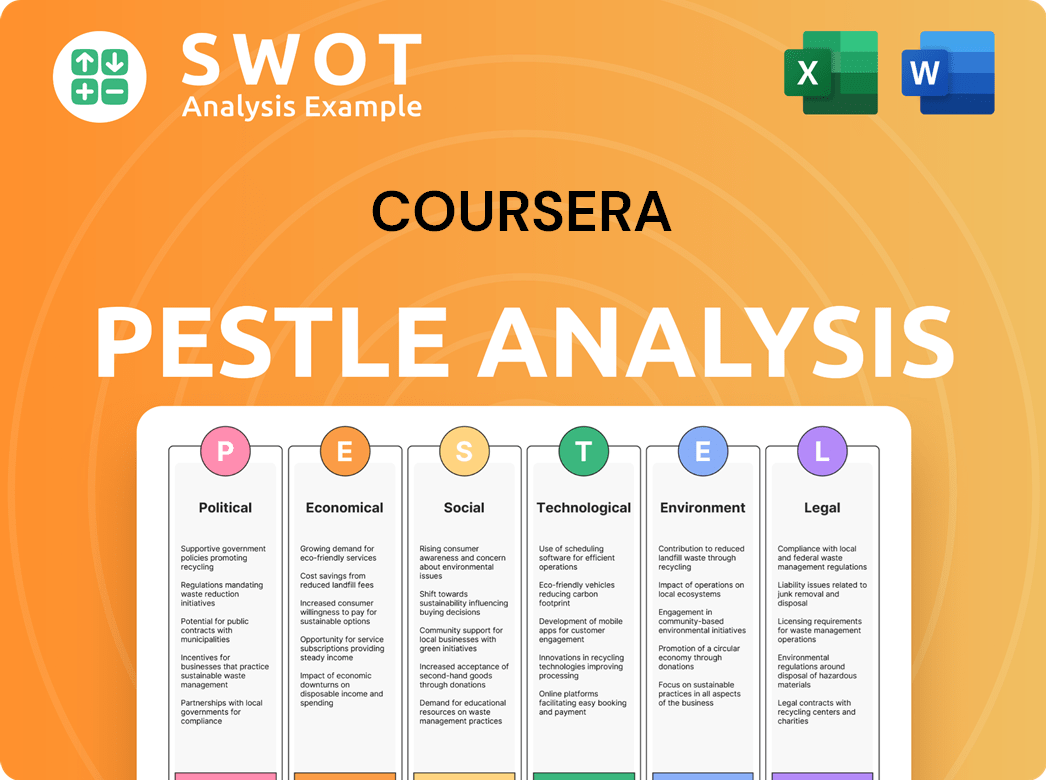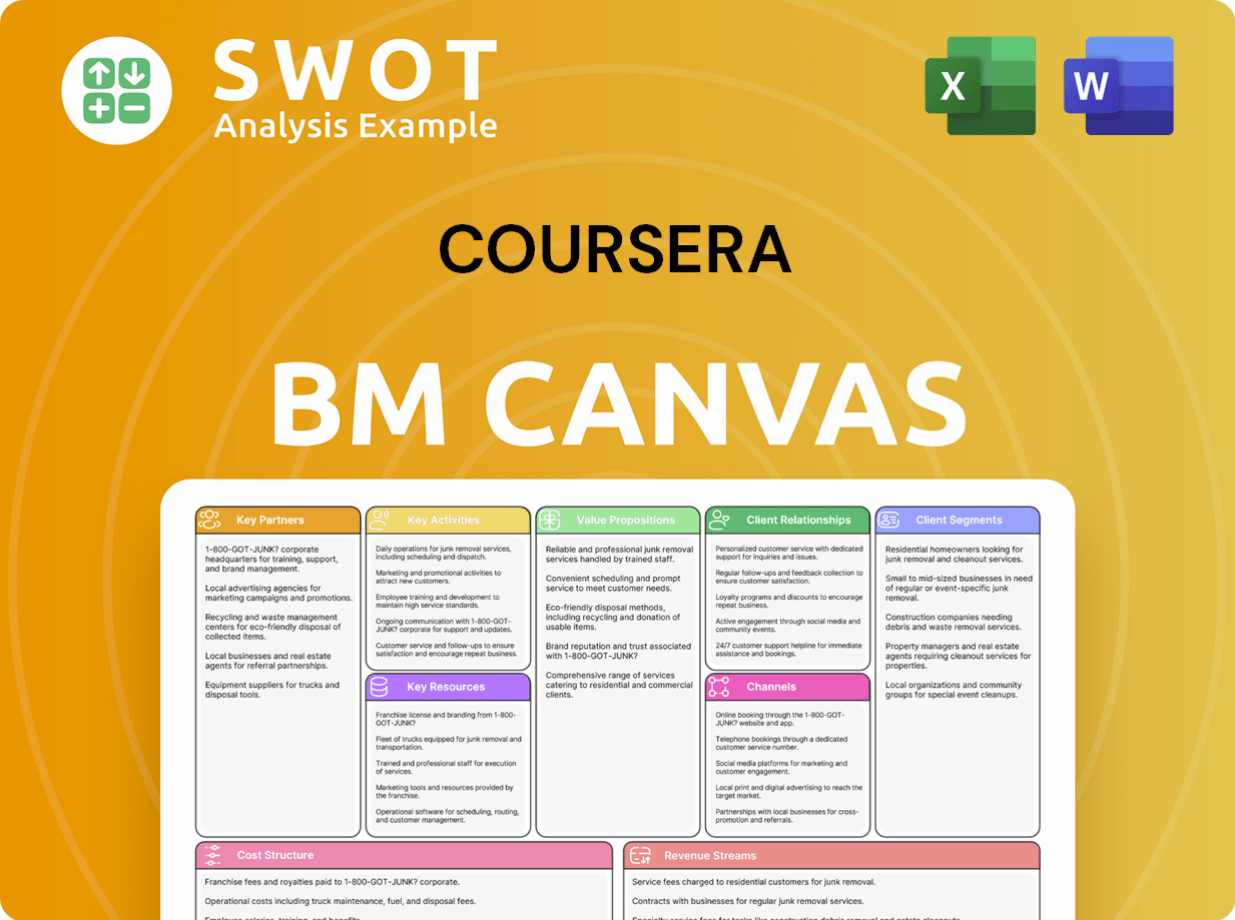Coursera Bundle
Who are Coursera's Customers?
In today's rapidly evolving educational landscape, understanding the Coursera SWOT Analysis is key to success. Coursera's journey, from a Stanford University initiative to a global online learning platform, is a testament to the power of understanding its customer demographics and target market. The company's expansion, fueled by shifts in online learning, necessitates a deep dive into who uses Coursera and why.

This analysis will dissect the Coursera target market, exploring Coursera user profiles from age and location to education and professional backgrounds. We'll examine Coursera users motivations, platform usage, and how the company strategically caters to its diverse audience. This comprehensive look at customer demographics will reveal how Coursera maintains its leading position in the competitive online education sector.
Who Are Coursera’s Main Customers?
Understanding the customer demographics and target market of the online learning platform is crucial for strategic planning. Coursera, a leading provider in the education technology sector, caters to a diverse global audience. This analysis breaks down the primary customer segments, providing insights into their characteristics and behaviors.
Coursera's primary customer segments are broadly categorized into Consumer, Enterprise, and Degrees. Each segment has unique characteristics and contributes differently to the overall revenue and growth of the company. Analyzing these segments helps to understand the platform's reach and effectiveness in different markets.
The Consumer segment remains the largest, indicating the platform's strong appeal to individual learners worldwide. The Enterprise segment highlights the growing demand for corporate and government training solutions. The Degrees segment, although experiencing revenue adjustments, reflects strategic shifts in the higher education market.
The Consumer segment is the largest, with revenue of $398.1 million in 2024, a 9% increase. This segment includes individual learners from over 230 countries, with 168.2 million registered users by the end of 2024. Coursera's Marketing Strategy of Coursera focuses on attracting and retaining these individual learners.
Approximately 46% of Coursera users globally are women, with some countries like Mexico (51%) and Colombia (50%) achieving gender parity. The median age of learners varies, with around 35 in Europe and 29 in Indonesia. These statistics help in understanding the Coursera audience.
The Enterprise segment, including Coursera for Business, Government, and Campus, generated $238.9 million in revenue in 2024, up 7% year-over-year. The total number of Paid Enterprise Customers increased by 18% year-over-year to 1,612 in 2024. This segment is a key area for growth.
The Degrees segment saw a 22% increase in degree students to 26,700 in Q4 2024. However, Coursera plans to reduce investment in this area in 2025. This shift reflects a strategic focus on integrating course content into existing university programs.
Coursera's target market is broad, encompassing individual learners, businesses, governments, and educational institutions. The platform's success is driven by its ability to cater to diverse needs and demographics. Understanding the specific characteristics of each segment is vital for refining marketing strategies and product offerings.
- The Consumer segment is the largest, driven by individual learners seeking skill development.
- The Enterprise segment is growing, reflecting the demand for corporate training.
- The Degrees segment is undergoing strategic adjustments.
- Coursera's user base is global, with varying demographics across regions.
Coursera SWOT Analysis
- Complete SWOT Breakdown
- Fully Customizable
- Editable in Excel & Word
- Professional Formatting
- Investor-Ready Format

What Do Coursera’s Customers Want?
Understanding the customer needs and preferences is crucial for the success of any online learning platform. For the platform, the primary drivers for its users are career advancement, skill development, and personal enrichment. The platform's customer base is largely composed of career-focused learners, with roughly 85% of its users falling into this category.
Many users are seeking to acquire new skills to enhance their employment prospects, secure new job opportunities, or improve their performance in their current roles. This is evident in the high demand for entry-level Professional Certificates, which saw over 3.3 million enrollments in 2024. The platform's ability to adapt to market trends and provide relevant content is key to meeting these diverse needs.
The platform's focus on providing high-quality, modular content and credentials at various skill levels, price points, and durations caters to a broad audience. The platform also addresses common pain points by providing high-quality, modular content and credentials at varying skill levels, price points, and durations. This approach ensures that the platform remains a valuable resource for a wide range of learners seeking to enhance their skills and advance their careers. This aligns with the platform's strategic initiatives, such as the integration of Degrees into the Consumer segment, aiming to simplify the learner journey.
The platform's users are increasingly interested in digital and AI-related skills. In 2024, the platform launched over 450 generative AI courses, with courses like Google AI Essentials and Generative AI for Everyone being highly popular. Generative AI enrollments surged by 195% year-over-year, averaging 12 enrollments per minute in 2025.
- The platform's users are increasingly opting for role-focused content to prepare for specific jobs, reflecting a preference for practical, job-relevant skills.
- Feedback and market trends directly influence product development, leading to initiatives like AI-enabled Course Builder for streamlined content production and foreign language translation for broader accessibility.
- The platform also tailors marketing and product features; for instance, the integration of Degrees into the Consumer segment in Q1 2025 aims to simplify the learner journey, reflecting a strategic bet that learners will increasingly move along a continuum of education from micro-credentials to degrees.
- For more insights, you can also explore the information available about Owners & Shareholders of Coursera.
Coursera PESTLE Analysis
- Covers All 6 PESTLE Categories
- No Research Needed – Save Hours of Work
- Built by Experts, Trusted by Consultants
- Instant Download, Ready to Use
- 100% Editable, Fully Customizable

Where does Coursera operate?
The online learning platform, Growth Strategy of Coursera, boasts a substantial global footprint, reaching learners worldwide. As of the end of 2024, the platform served 168.2 million registered learners across over 230 countries and territories, demonstrating its extensive reach and appeal. This widespread presence highlights the company's success in attracting a diverse global audience.
North America represents a significant market for the platform, with a substantial learner base. The region accounts for 31.2 million learners, with the United States contributing 27.7 million and Canada adding 4 million. Europe also shows strong engagement, hosting 24.5 million learners. These numbers underscore the platform's strong presence in developed markets.
The platform's influence extends deeply into emerging markets, with India leading in enrollments, boasting 24.6 million learners. India also shows the highest mobile app usage at 53%. The platform's global strategy is clearly focused on expanding its reach and impact across diverse geographical regions.
The platform is available in over 230 countries and territories, demonstrating its global presence. North America and Europe represent key markets, with significant learner bases. Emerging markets, particularly India, show strong growth and engagement.
India leads in enrollments with 24.6 million learners and the highest mobile usage. The Philippines has the highest female participation, at 51%. Malaysia excels in STEM engagement, reaching 34%. Indonesia has the youngest learners, with a median age of 29.
The platform offers content in up to 24 languages through its foreign language translation initiative. AI-translated courses are completed 25% faster than non-translated courses. This localization effort is key to its global strategy.
Demand for GenAI learning has surged in emerging markets. Enrollments have more than doubled across Asia Pacific, the Middle East, and Africa. Latin America saw the highest increase, with a 425% rise. This highlights the platform's relevance in these regions.
The platform continues to expand through strategic partnerships. A recent example is the collaboration with the Higher Education Commission (HEC) Pakistan, which aims to equip up to 120,000 students with in-demand skills. These initiatives support the platform's global growth and efforts to bridge skills gaps worldwide.
- The platform's global presence is significant, with learners in over 230 countries.
- North America and Europe represent major markets, while India leads in enrollments.
- Localization through language translation and strategic partnerships fuels global expansion.
- Emerging markets show strong growth, particularly in GenAI learning.
Coursera Business Model Canvas
- Complete 9-Block Business Model Canvas
- Effortlessly Communicate Your Business Strategy
- Investor-Ready BMC Format
- 100% Editable and Customizable
- Clear and Structured Layout

How Does Coursera Win & Keep Customers?
The customer acquisition and retention strategies of the online learning platform, are multifaceted, focusing on both individual learners and enterprise clients. The platform leverages a freemium model for attracting individual users, offering free access to some content while charging for certifications and premium content. This approach has proven effective, with the company adding a significant number of new registered learners in 2024.
For businesses and institutions, the platform targets upskilling and reskilling initiatives through its enterprise segment. This B2B and B2G strategy involves partnerships with various organizations to provide tailored training programs. Retention strategies are also crucial, including enhancing the learner experience through innovations and promotional offers. Understanding customer lifetime value (CLV) is a key metric that informs decisions on customer acquisition, retention, and relationship management.
The company's focus on expanding its course offerings, especially in high-demand areas like generative AI, further supports its retention efforts. By continually updating its content library, the platform ensures it remains relevant and valuable to its users, driving continued engagement and subscription renewals. The platform's approach to customer acquisition and retention is a blend of strategic partnerships, innovative product offerings, and data-driven decision-making to foster long-term growth and user loyalty.
The freemium model is a primary acquisition method, allowing access to some content for free. Payment is required for premium content and certifications. This approach is designed to attract a broad range of learners by providing initial value without immediate financial commitment.
The enterprise segment focuses on upskilling and reskilling employees. This involves partnerships with businesses and institutions. The platform tailors training programs to meet the specific needs of these organizations, offering a B2B/B2G acquisition strategy.
Coursera Plus provides unlimited access to a significant portion of the platform's catalog. The subscription model drives consumer revenue. This offering is a key driver for consumer revenue growth.
The platform invests in new content, particularly in high-demand areas. The launch of over 450 courses in 2024, including generative AI, plays a significant role in retaining learners. This strategy keeps the platform relevant and valuable.
The platform's strategies for attracting and retaining users are diverse, targeting both individual learners and enterprise clients. The freemium model, coupled with the Coursera Plus subscription, drives consumer revenue. The enterprise segment, focusing on upskilling and reskilling programs, expands the platform's reach to businesses and institutions. Retention efforts are enhanced through innovations like Coursera Coach and continued investment in new content, particularly in high-demand areas. For more insights, you can explore the Growth Strategy of Coursera.
The freemium model allows access to some content for free, with payment required for certifications and premium content. The Coursera Plus subscription provides unlimited access to a significant portion of the platform's catalog, driving consumer revenue. This model is designed to attract a broad user base while generating revenue through premium offerings.
The enterprise segment focuses on upskilling and reskilling employees through partnerships with businesses and institutions. This B2B/B2G strategy includes collaborations with organizations like Banco Santander and Schneider Electric. These partnerships provide tailored training programs, expanding the platform's reach and revenue streams.
Retention strategies include enhancing the learner experience through innovations like Coursera Coach. The platform offers alternative promotions, such as free trials and discounts. Understanding customer lifetime value (CLV) informs decisions on customer acquisition, retention, and relationship management.
The platform invests in new content, particularly in high-demand areas like generative AI. The launch of over 450 courses in 2024, including generative AI, keeps the platform relevant and valuable. This strategy ensures the platform meets evolving user needs and interests.
The platform added 26.3 million new registered learners in 2024, reaching a total of 168.2 million by year-end. Consumer revenue in Q4 2024 was $101.7 million, up 5% year-over-year. The total number of Paid Enterprise Customers increased to 1,612 in 2024, an 18% year-over-year increase.
The platform offers promotional options, such as a 7-day free trial for Coursera Plus Monthly and a $100 discount on the annual plan. These offers are designed to incentivize new sign-ups and encourage subscription renewals, supporting both acquisition and retention.
Coursera Porter's Five Forces Analysis
- Covers All 5 Competitive Forces in Detail
- Structured for Consultants, Students, and Founders
- 100% Editable in Microsoft Word & Excel
- Instant Digital Download – Use Immediately
- Compatible with Mac & PC – Fully Unlocked

Related Blogs
- What are Mission Vision & Core Values of Coursera Company?
- What is Competitive Landscape of Coursera Company?
- What is Growth Strategy and Future Prospects of Coursera Company?
- How Does Coursera Company Work?
- What is Sales and Marketing Strategy of Coursera Company?
- What is Brief History of Coursera Company?
- Who Owns Coursera Company?
Disclaimer
All information, articles, and product details provided on this website are for general informational and educational purposes only. We do not claim any ownership over, nor do we intend to infringe upon, any trademarks, copyrights, logos, brand names, or other intellectual property mentioned or depicted on this site. Such intellectual property remains the property of its respective owners, and any references here are made solely for identification or informational purposes, without implying any affiliation, endorsement, or partnership.
We make no representations or warranties, express or implied, regarding the accuracy, completeness, or suitability of any content or products presented. Nothing on this website should be construed as legal, tax, investment, financial, medical, or other professional advice. In addition, no part of this site—including articles or product references—constitutes a solicitation, recommendation, endorsement, advertisement, or offer to buy or sell any securities, franchises, or other financial instruments, particularly in jurisdictions where such activity would be unlawful.
All content is of a general nature and may not address the specific circumstances of any individual or entity. It is not a substitute for professional advice or services. Any actions you take based on the information provided here are strictly at your own risk. You accept full responsibility for any decisions or outcomes arising from your use of this website and agree to release us from any liability in connection with your use of, or reliance upon, the content or products found herein.